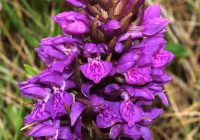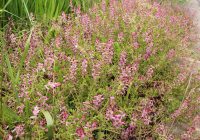Dr Phil Smith’s Wildlife Notes
May 2015
Persistent cold winds from the west and northwest were an unwelcome feature of May this year. Although these reduced the variety of migrant birds and slowed the appearance of wild flowers and insects, our coastline still produced plenty of interest. Fortunately, occasional rain meant that what little surface water remained from the April drought was kept topped up. Therefore Natterjack tadpoles on Birkdale Green Beach survived throughout the month, though their growth rate was slower than normal.
Devil’s Hole at Ravenmeols remained dry throughout but, early in the month, I had a first sighting here of the rare coastal form of Groundsel, while masses of the stunning sky-blue Heath Dog-violetvied for attention with the first flowers of Common Milk-wort. In this case the latter were pink, though white or various shades of blue and purple are also regular in this variable species. A passing walker commented on the large number of “bugs” flying around. They were St Mark’s flies, named after St Mark’s day, 25th April, though these harmless black hairy flies with dangling legs often swarm well into May. Their larvae feed on rotting vegetation in the soil, the adults often nectaring on willow catkins.
The following day, I was exploring the Cabin Hill frontal dunes where the vegetation is now completely recovered from the big fire two years ago. The retreating tide revealed thousands of waders massing on the shore, their migration to northern breeding grounds blocked by adverse winds. Six Whimbrel flew inland, their characteristic call reminiscent of a man whistling his dog, while the harsh cries of Sandwich Terns could be heard over the distant sound of the surf. A singing Grasshopper Warbler perched in full view only 20m away in a Hawthorn bush, giving my best ever views of this usually skulking songster. Nearby, a female Whinchat was another reminder of spring in the dunes. Once a breeder here, it only appears on passage these days.
Two visits to The Lancashire Wildlife Trust’s Haskayne Cutting Nature Reserve a few miles inland were rewarded with a male Brimstone, a butterfly that seems to be increasing locally, as well as the more usual Orange Tips. Also doing well here is the Northern Marsh-orchid, Patricia Lockwood and I counting 529 deep-purple flower-spikes where annual late-summer mowing maintains suitable habitat.
We also went to Crosby, Blundellsands and Hightown to monitor the Isle of Man Cabbage. This is one of the most important Sefton Coast plants, being largely confined to northwest England shores. It is also a British endemic, not found in any other country. The good news is that the Isle of Man Cabbage is flourishing. It likes bare sand and has benefitted from the disturbance caused by the 2011 sea-defence works at Crosby and Hightown. The Blundellsands colony hadn’t been counted since 2010, so we were pleased to record a 14% increase from 514 to 588 plants.
On our way to Blundellsands, we spotted an impressive stand of fumitories lining the roadside opposite Little Crosby Church. Always a challenge to identify, these turned out to be mostly the regionally rare salmon-pink Tall Ramping-fumitory of the endemic western variety hibernica. Equally attractive were occasional plants of Common Fumitory and Common Ramping-fumitory, while the presence of the much rarer Purple Ramping-fumitory was a strong possibility, though not confirmed.
There are not many records of Northern Dune Tiger Beetle south of the Alt, so on a suitably sunny day in mid-May I searched areas of the Hightown dunes with patches of bare sand. The ridges near the Sailing Club created during the 2011 coast protection scheme produced an exceptional count of 13 adults. Nine more were on the open frontal dunes further south. Apart from the Sefton Coast, this nationally rare insect is only known from Drigg, Cumbria, where past literature suggested it was declining. However, a 2014 paper by Hewitt & Thomas in Lakeland Naturalist reports that 1570 beetles were counted during three visits in summer 2013, indicating that the population is healthy and maybe even larger than Sefton’s.




